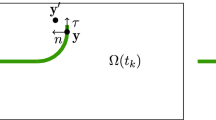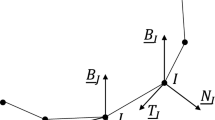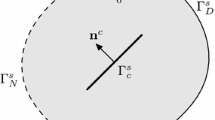Abstract
This paper describes the fundamental modeling approaches adopted for crack nucleation and propagation in a software system that is specifically designed to simulate problems with evolutionary geometry. Only the topological and geometrical aspects of crack modeling, and how these aspects affect the database representation in the system, are addressed in the present discussion. The following are the innovative features of the present crack modeling approach: (a) crack simulation is done with a true geometric representation of the structure, via solid modeling; (b) crack modeling relies on the sophisticated, topology-based data structure of this system to support linkage to the solid model, fast interaction and accurate representation of evolving flaw shapes; (c) the system provides the ability to specify flaws of arbitrary shape (including non-planar flaws), size and orientation at arbitrary locations in the geometric model; (d) the flaw is specified at the desired location in the actual structure geometry, rather than at a location in the mesh; (e) the system uses all its automatic and local remeshing capabilities for the simulation of flaw initiation and growth.
Similar content being viewed by others

References
Wawrzynek, P.A.; Martha, L.F.; Ingraffea, A.R. (1988) A computational environment for the simulation of fracture processes in three dimensions, Analytical, Numberical, and Experimental Aspects of Three Dimensional Fracture Processes, ASME AMD 91, pp 321–327
Wawrzynek, P.A.; Martha, L.F.; Ingraffea, A.R. (1990) Fransys: a software system for the simulation of crack propagation in three dimensions, Proceedings of IUTAM/IACM Symposium on Discretization Methods in Structural Mechanics, Vienna, Austria, July 1989, 273–282
Martha, L.F.; Wawrzynek, P.A.; Ingraffea, A.R. (1990) Simulation of arbitrary crack propagation in three dimensions, Numerical Methods in Fracture Mechanics—Proceedings of the Fifth International Conference Freiburg, Germany, April (Luxmoore, A.R.; Owen D.R.J., Editors) Pineridge Press, 115–127
Martha, L.F. (1989) Topological and geometrical modeling approach to numerical discretization and arbitrary crack propagation in three dimensions, PhD Thesis, Cornell University, Ithaca, NY. Report 89-9, School of Civil and Environmental Engineering, Cornell University
Bartels, R.H.; Beatty, J.C.; Barsky, B.A. (1987) An Introduction to Splines for Use in Computer Graphics and Geometric Modeling, Morgan Kaufmann, San Mateo, California
Böhm, W.; Farin, G.; Kahmann, J. (1984) A survey of curve and surface methods in CAGD, Comput. Aided Geom. Design, 1, 1–60
Barsky, B.A.; Greenberg, D.P. (1980) Determining a set of B-spline control vertices to generate an interpolating surface, Comput. Graph. Image Procsng, 14, 203–226
Weiler, K. (1988) The radial-edge structure: a topological representation for non-manifold geometric boundary representations, Geometric Modelling for CAD Applications, North-Holland, Amsterdam, 3–36
Wawrzynek, P.A.; Ingraffea, A.R. (1987) Interactive finite element analysis of fracture processes: an integrated approach, Theor. Appl. Fract. Mech., 8, 137–150
Bonne, T.J.; Wawrzynek, P.A.; Ingraffea, A.R. (1986) Simulation of the fracture process in rock with applications to hydraulic fracturing, Int. J. Rock Mech. Min. Sci. 23, 255–265
Boone, T.J.; Ingraffea, A.R.; Rogiers, J.C. (1989) Visualization of hydraulic driven fracture propagation in poroelastic media using superworkstations, J. Petrol. Tech., 41, 574–580
Sousa, J.L. (1992) Three-dimensional simulation of nearwellbore phenomena related to hydraulic fracturing from a perforated, arbitrarily oriented wellbore, PhD Thesis, Cornell University, Ithaca, NY
Haber, R.; Abel, J.F. (1982) Discrete transfinite mappings for the description and meshing of three-dimensional surfaces using interactive computer graphics, Int. J. Num. Meth. Engng, 18, 41–66
Sousa, J.L.; Martha, L.F.; Wawrzynek, P.A.; Ingraffea, A.R. (1989) Simulation of non-planar crack propagation in threedimensional structures in concrete and rock, Fracture of Concrete and Rock: Recent Developments (Shah, S.P.; Swartz, S.E.; Barr, B., Editors), Elsevier Applied Science, London, 254–264
Martha, L.F.; Llorca, J.; Ingraffea, A.R.; Elices, M. (1991) Numerical simulation of crack initiation and propagation in an arch dam, Dam Engng, 2, 3, 193–213
Ingraffea, A.R.; Manu, C. (1980) Stress intensity factor computation in three dimensions with quarter-point elements, Int. J. Num. Meth. Engng, 15, 1427–1445
Weiler, K. (1986), Topological structures for geometric modeling, PhD Thesis, Rensselaer Polytechnic Institute, Troy, NY
Mäntylä, M. (1988) An Introduction to Solid Modeling, Computer Science Press, Rockville, Maryland
Author information
Authors and Affiliations
Rights and permissions
About this article
Cite this article
Martha, L.F., Wawrzynek, P.A. & Ingraffea, A.R. Arbitrary crack representation using solid modeling. Engineering with Computers 9, 63–82 (1993). https://doi.org/10.1007/BF01199046
Issue Date:
DOI: https://doi.org/10.1007/BF01199046



